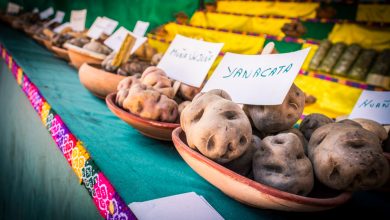Fire of Peru, Mother Sauce at the Stove: Ricardo Zárate’s Cookbook

Chef Ricardo Zarate (Alex Reznik)
Big and bold, like his title—yet also subtle, like his reworking of a Peruvian standard on its cover—Lima-born, Los Angeles Chef Ricardo Zaráte delivers in his recently published The Fire of Peru: Recipes and Stories from My Peruvian Kitchen.
Replete with perfect stories and thoughtful presentations of a wide range of Peruvian cuisine, Chef Zárate rethinks and reworks Peruvian cooking. His cookbook takes classics, dishes from the Japanese and Chinese Peruvian traditions, as well as dishes invented in his kitchen and presents them for the home cook so they can make them with ingredients available now in the United States.
Chef Zárate has become a brand, expansive and attractive. He burst into the sky over Los Angeles in a chrysanthemum of light. That celestial fire of bright colors becomes both Peru and Zárate´s personal kitchen, in this book, to which we all are invited.

Zárate gives us recipes, and also stories, as befits a cookbook that invokes the flames shooting out of a Peruvian stove. He grew up in the ancient, glorious and yet very hard scrabble neighborhood of Rimac in Lima, Peru. Named for the God-who-Talks, that site saw the rise and fall of civilizations as ancient and great as any in the world.
He tells of his parents saving every céntimo (penny) to buy cement and slowly but surely build a home, even if the walls are not professionally done and in one place bows like a llama’s neck. Zárate fits the dream of so many Peruvian youth to rise and claim the world. In his case it took him to London where he did culinary school for the second time and learned Japanese cuisine, before his star came to the City of Angels.
The stories charm, as if we were sitting in his home in Rimac and listening to him talk while he elegantly tosses food in a Peruvian wok over the intense flame, and dishes it up, fresh, fragrant, and steaming before us.
But the recipes. They are the backbone of the book, the night sky in which fireworks illuminate. And it is to that sky that Zárate dedicates careful attention.
He focuses attention on that-without-which there can be no Peruvian cuisine, the aderezo. The focus and the arguments over aderezos. Oh my God! Yet Zárate transforms the notion into one right out of Le Guide Culinaire by August Escoffier, the Bible of French cuisine. Zárate makes them the master “sauces” of Peruvian cuisine and they become the night sky from which his creations explode brightly onto the table.
His favorite, he gender bends and it becomes the mother sauce, that-without-which-there-is-not. It gives birth to a myriad of dishes and in itself is a generative marvel.
Zárate dutifully explains how to make the sauce by first making the key ingredients, a garlic paste as well as pastes from yellow and red ají, Peruvian peppers. Then he gives the shortcut for the home cook, the bottles of colorful pepper paste carried in Latin markets and upscale grocers these days throughout the United States.
“Having a mother sauce”, he writes, “helps the cook keep all the different, and sometimes independently bold, flavors in Peruvian cooking balanced.” (p. 196).
In joining red and yellow together, two of the sacred colors and two sacred flavors, over flames until they meld and lightly brown, Zárate picks up what is basic in ancient Peruvian cosmology and modern cooking. It is an esthetic and a holy wonder. It brings “a spicy and smoky-sweet flavor balance” that is at the base of much Peruvian cuisine.
Sometimes the sauces are added at the end of cooking to give that perfect touch of flavor while many other times, like the mother sauce, they are there at the beginning and without-them-there-is-no-dish.
You can read the cookbook from front to back, if you wish, or you can look in the index under sauces. marvel at the variety, and then follow them through the book as a cook would. They are the mother by her stove, children all around while pots sizzle and hiss.
Ricardo Zárate and Jenn Garbee, The Fire of Peru: Recipes and Stories from My Peruvian Kitchen (Houghton Mifflin Harcourt, 2015).






